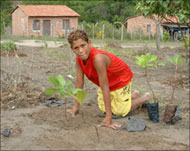Brazil’s landless peasants are hopeful
Marcelo da Silva Amorim, 26, shows off his plot with pride.

Among the goats and chickens are the shoots of freedom.
Huge bushes of red and green cashews, a bumper crop of passion fruits, swathes of mandioca and the struggling leaves of pumpkins.
A former landless farmer and now a landowner, “my freedom is priceless”, he says.
Holding his one-year-old son in his arms, Marcelo tells how the landless peasants movement Movimento Sem Terra, or MST, has changed his life.
MST is the largest organisation outside political parties in Brazil.
Negative coverage
|
|
|
The camps provide children with |
“It´s important that there will be a job for my son when he grows up. If not, what is he going to do? Go to the city [which is] full of drugs and problems?” he asks.
His father disagreed with him joining the Movimento Sem Terra five years ago.
The organisation is often demonised in the media but Marcelo is almost evangelical about it.
“I’ve learnt so much in that time, how to improve my crops, studying philosophy, understanding how the international markets work. I get quite emotional when I recall what I have had to go through to reach this point.”
Several times his crops and their temporary shelters were razed to the ground.
Uphill battle
“The struggle never stops. First, it’s the struggle for land. Then it’s the struggle for constructing your house, then for education, health, water. It’s tiring. Day to day it doesn’t stop, there’s always so much to do,” says Marcelo.
His plot is in the encampment of Nova Penima, a two-hour drive from the city of Salvador in Bahia and one of many in the region.
In 1997, a group of landless people arrived and set up a camp by the side of the site.
The federal government bought the unused land from a metal works, for $30,000.
After a struggle, the government agreed to give ownership rights to the landless.
Each family took out a $2,600 loan payable over 13 years
to buy their plots, seeds, tools, bricks, and mortar. It now houses 58 families.
 |
|
Bito, 12, plants cashew in the |
There is a functioning school but the camp does not yet have electricity, relying on car batteries to supply the sparse radio and television sets and using diesel fuel lamps and gas burners for cooking.
Land distribution
In November, 1000 landless peasants marched on the capital Brasilia to demand a meeting with President Luiz Inacio Lula da Silva to speed up the agrarian reform process. The President complied.
The MST, one of the key members of the National Forum for Agrarian Reform, met with the Agrarian Development Minister Miguel Rossetto in December to discuss the implementation of the National Land Reform Programme.
One percent of landowners control 46-50% of the land in Brazil, one of the worst levels of land distribution in the world.
There are 850 million hectares of land with more than 300 million hectares fertile, yet Brazil only uses 35 million hectares.
There are more than 85,000 families camped at the edge of roads throughout Brazil, living in precarious conditions and waiting to move on to land.
